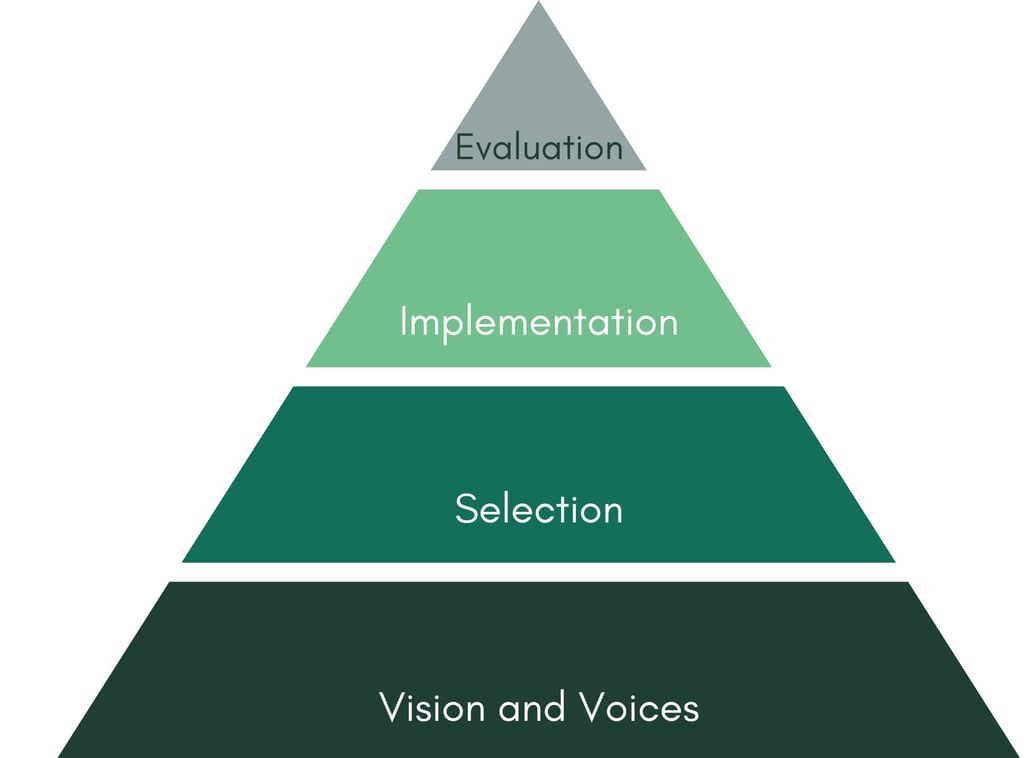Chapter 1. How To Choose EdTech For Your School: 4-Step Framework
Feeling overwhelmed by all the edtech tools and resources out there? We get it. Here’s how you can navigate the options and choose what works best for you and your students.
TEACHINGLEADERSHIP
Olia Tomski
1/27/20254 min read


EdTech can be overwhelming, but with the right approach, you can create a system that helps you choose tools that truly meet the needs of both teachers and students. It can be a powerful tool that can be used to accomplish goals, streamline processes, and improve outcomes. This simple four-step framework will guide you in selecting tools that will be effectively used and create meaningful, equitable outcomes for your school. This is Chapter 1 on Vision and Voices.
The foundation of successful EdTech integration is combining your school’s vision for teaching and learning with the input of your stakeholders. Together, these elements create a strong base for all other steps—selection, implementation, and evaluation. A clear vision provides purpose, while stakeholder voices ensure shared responsibility and collaboration making these decisions practical, inclusive, and impactful.
Chapter 1.
Vision and Voices

Your school’s vision defines
the "why"
behind your efforts.
It articulates the bigger picture: improving student outcomes, fostering equity, and creating transformative learning experiences. For example, a school committed to personalized learning might prioritize tools that adapt to individual student progress, while one focused on career readiness might emphasize platforms for skill-building and certifications.
For schools offering virtual and hyflex classes, the vision might include creating seamless experiences for remote and in-person learners, requiring tools that support collaboration across formats. Similarly, schools with multi-level classes may seek tools that facilitate differentiation, allowing teachers to deliver tailored content and track progress for students at varying skill levels.
By anchoring your decisions to this vision, you ensure that technology isn’t just a flashy addition but a tool that aligns with your mission.
Vision
Before gathering input, we need to ask:
What’s the one thing we can do to align EdTech with our school’s vision and goals—such that everything else becomes easier or promotes student success?
This focusing question—adapted from The One Thing by Gary Keller—acts as both a big-picture guide and a small-focus filter. It ensures we are making high-leverage decisions, rather than simply reacting to the latest tool or trend.


By defining our Vision with this level of clarity, we set the stage for meaningful EdTech adoption that serves teachers, students, and parents.

Stakeholders bring
the "how" and "who"
to your vision, ensuring that decisions reflect the unique needs and dynamics of your school community
Who’s using it? Who’s running it? Who’s impacted the most? These are the critical questions to ask as you gather input. Don’t just listen to the loudest voices in the room—include perspectives of English learners, special education students, and their families.
Regardless of the strategies you use to engage stakeholders (surveying, focus groups, etc), ensure that the format is accessible to everyone. This might mean conducting focus groups on platforms with features like closed captioning or offering surveys in multiple languages. It could also mean prioritizing stakeholder availability by holding meetings in the evenings or accommodating different time zones for remote participation. These thoughtful adjustments make it easier for all voices to be heard and valued.
For example, in a school offering hyflex classes, stakeholder input might reveal that existing tools don’t adequately support synchronous collaboration between virtual and in-person learners. Or, in multi-level classes, teachers might highlight the need for tools that enable differentiated instruction, such as platforms that allow students to access materials at their own pace while providing teachers with real-time progress data. These insights ensure that EdTech solutions meet real-world classroom challenges.
Shared Goals and Collaboration
A vision without input risks being disconnected from classroom realities, while stakeholder feedback without a unifying vision can lead to fragmented decisions. Unifying these ensures that your EdTech strategy is both aspirational and actionable.
Example of Shared Goals: A school aiming to strengthen parent-teacher communication could engage families and staff in selecting a centralized communication platform. By aligning on this goal, the school ensures that families stay informed and involved in their children’s education, creating a stronger support network for student success.
Example of Collaboration: A middle school implementing language learning tools can partner with ESL teachers and families to select platforms that support bilingual development, ensuring buy-in and practical use.
When your vision and stakeholder input work hand-in-hand, EdTech decisions become purposeful, inclusive, and effective—laying the groundwork for success across every level of your school system.
Making It Actionable
To unify vision and stakeholder input:
Start with your school’s goals, then invite stakeholders to identify challenges and brainstorm solutions that align with those objectives.
Survey stakeholders. Tailor questions to connect your vision with real needs of each stakeholder (e.g., “How could technology better support differentiated instruction?”).
Engage stakeholders to pilot tools that embody the school's vision, then evaluate the tool based on the results and their feedback.
Because Edtech decisions directly impact your stakeholders, including students, their families, teachers, and school and system leaders, provide meaningful opportunities to engage all stakeholders within the selection, implementation, and evaluation processes within your edtech system.
Use this survey as a starting point!
Click the button to access a model survey with three tailored paths—Educators, Students, and Parents.
Download or make a copy to customize it to fit your school's needs
